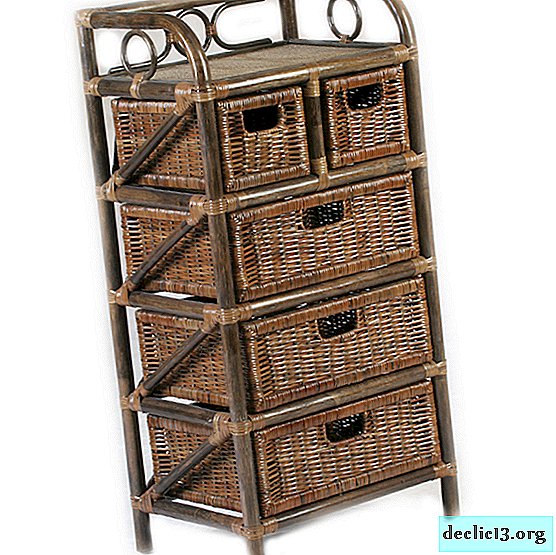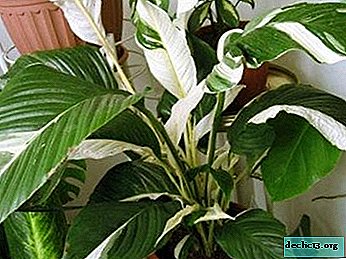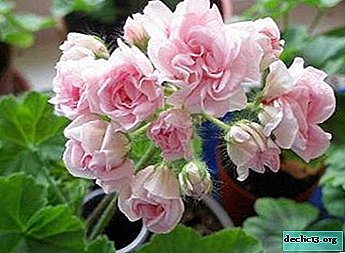Tender rose Talea: description and photo of the variety, flowering and use in landscape design, care and other nuances
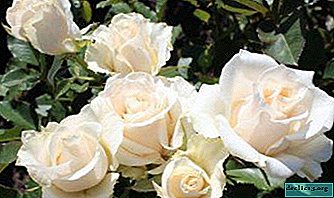
Rosa Taleya is a hybrid tea variety with an unusual appearance.
It attracts attention with its delicate coloring and elegant appearance of the bush. Currently actively cultivated by flower growers.
From the article you will learn more about this variety of roses, see how the flower looks in the photo. Read about the features of plant care and methods of reproduction ...
Grade description
Bush of a bush dense, compact, reaches a height of one meter. The shoots are straight, vertical, durable. On one stalk, one bud or inflorescence is tied in the form of a brush, consisting of 3-4 flowers. The leaves are rather large, densely cover the shoots, painted in a deep dark green color.
Flowers, not large, round or oblong, up to 10 cm in diameter. The flower is medium-double, combines up to 40 leathery petals with scalloped edges.
The color of the flowers can be pink, cream, apricot, light orange or ivory. At the tips of the petals, you can notice light overflows of cream and green shades.The variety is resistant to fungal infection. Rosa Taleya is characterized by medium winter hardiness, which allows it to grow in a temperate climate.
Photo
Further on the photo you can see what the Taleya rose variety looks like.




Advantages and disadvantages
This variety has earned great popularity among flower growers due to its advantages. The main advantages of the Teleya variety are:
- beautiful shape of the bud;
- a large number of colors;
- large flower size;
- medium resistance to high humidity and low temperature.
Among the shortcomings, there are special requirements for planting conditions and agricultural technology, especially for pruning.
History of occurrence
Thalea refers to hybrid tea, or large-flowered roses. The variety was bred in the Netherlands in 2004 by Lex Vurn for cultivation in the open field and for use in cutting.
Bloom
The flowering period at the Thaleus rose begins in late May and lasts until late autumn. The flower opens slowly, smoothly, when the bud opens in its center a small pink spot is visible. The delicate aroma gives the rose a special sophistication..
What to do if it does not bloom?
 Rosa Talea may refuse to bloom for the following reasons:
Rosa Talea may refuse to bloom for the following reasons:
- wrong choice of landing place;
- Incorrect trimming
- lack or excess of fertilizing;
- the presence of root shoots;
- bush aging.
In this case, remove the extra shoots, trim to the place of formation of a new shoot and feed the plant with potash fertilizer.
Use in landscape design
The variety is often used to design personal plots. The shrub looks good in the form of a single planting and in a mixed flower bed. Bushes are often planted among low blue or gray firs.
Step-by-step care instructions
Seat selection
Taleya roses can grow in one place for 5-6 years. This should be considered when choosing a place. The plant prefers warmth and sunlight, so for it should devote a plot well lit by sunlight. Planting must be placed away from trees. At the same time, the place should be well ventilated and protected from cold wind and drafts.
The soil
A flower requires fertile, well-drained soil. The soil should absorb and retain moisture, while stagnation of water, which can cause rotting of the root system, is unacceptable.
Timing
Landing time depends on weather and climatic conditions. The most optimal is the end of April - the beginning of May.
Landing
 After choosing a place, prepare a landing hole with a depth and width of 0.5 meters. The roots in the pit should be located freely. Before planting, do drainage, fertilize and fill the hole with the planting mixture. The Thalea rose mix consists of garden soil, humus, sand and peat. After planting, trim - shorten the shoots for better future growth.
After choosing a place, prepare a landing hole with a depth and width of 0.5 meters. The roots in the pit should be located freely. Before planting, do drainage, fertilize and fill the hole with the planting mixture. The Thalea rose mix consists of garden soil, humus, sand and peat. After planting, trim - shorten the shoots for better future growth.
When buying seedlings, you should pay attention to the following signs:
- the root system must be branched and well developed;
- shoots lignified, dense, smooth, shiny, without spots and external damage;
- light roots on the cut.
Rose seeds germinate better in greenhouse conditions. Before planting, prepare planting material. Preparation consists of several stages:
- Stratification. Seeds are placed for 20 days on the bottom shelf of the refrigerator. Exposure to freezing temperatures will improve germination and increase disease resistance.
- Seed soaking for 6 - 8 hours in a solution of "Epina" or hydrogen peroxide.
- Sowing. Before sowing, containers should be prepared by filling them with nutritious soil consisting of turf land, sand and humus. Seeds should be evenly distributed over the soil surface and covered with glass to create a greenhouse effect.
- Watering carried out as the soil dries.
In the first year, seedlings from seeds are grown in containers. For the winter, the pots are brought into rooms where the temperature does not drop below 15 degrees. Care is to form a bush. Knotted buds should be removed. Watering is required as the topsoil dries. Mineral and organic top dressing should be applied weekly throughout the summer.
Temperature
Thalei roses need heat. The rose will grow and develop well at a temperature of 17-24C. At temperatures above 24C, the root system overheats, which negatively affects the absorption of nutrients and slows down the formation of buds.
Watering
Thalean roses are watered abundantly once every 7 to 10 days under the root. In hot weather, watering is increased. About one bucket of water should be spent on one bush. The best time is morning or evening. At the end of August, watering is reduced, and in September completely stopped. Do not use hoses, watering cans or sprinklers to moisten the soil.
Top dressing
 Plants feed in spring and autumn.
Plants feed in spring and autumn.
- In early spring, the main nitrogen-containing fertilizers are added.
- Three weeks before the start of active flowering, fertilizing with phosphorus-potassium fertilizers is carried out.
- In August, the bushes are fertilized with superphosphate and potassium sulfate to prepare the plant for winter.
If necessary, foliar top dressing can be carried out. To protect against insects, you can sprinkle foliage with wood ash.
Weeding
Before planting in the landing hole, the ground must be sieved. After planting, regular weed removal should be carried out manually or with a hoe. The number of weeds is affected by weather conditions.. Together with weeding, soil loosening is carried out, which increases the access of oxygen to the roots of the plant.
Pruning
Pruning allows you to activate the growth of young shoots and repeated flowering. It is held in spring and summer. With the onset of spring, broken, diseased and rotten branches are cut. Then remove the unproductive branches, on which last year there were flowers.
When forming pruning, attention should be paid to the appearance of the entire bush, remove unnecessary branches and trim the bush, leaving a third of the height of the plant. Forming pruning is carried out over 3-4 peephole. It will accelerate the growth of shoots from the base and will allow you to build a good skeleton. It should not be carried out every year, as this will weaken the bush and delay flowering for 2-3 weeks.
Transfer
Roses Taley can be transplanted in spring or autumn. The best time to move the bush in regions with a mild climate is autumn. In areas with cold winters, transplantation should be carried out with the onset of spring. It is easiest to transplant roses at the age of two to three years.
 The transplant is carried out in the following sequence:
The transplant is carried out in the following sequence:
- 2 to 3 days before transplanting, water the bush abundantly;
- dig a rose, departing from the base about 25 - 30 cm;
- if the transplant is delayed for 7 to 10 days, wrap the roots with a damp cloth and place the rose in a cool place;
- if the transplant is planned for a later date, then the dug shrub dug up;
- prepare a planting pit and fill it with a nutritious mixture of turf land, peat and bone meal;
- the day before planting, completely fill the hole with water;
- place the bush in a hole so that the grafting site is 3-5 cm below the ground;
- fill the hole with soil to half, lightly tamp and carefully pour. When the water is absorbed, fill the hole completely and pour.
Preparation for winter
Winter preparations begin in advance. At the end of summer, loosening, watering and pruning should be stopped. Shelter of roses for the winter is carried out by lowering the temperature to -3 ° C. If you do this earlier, roses under cover will germinate and vanish. As a covering material, fir spruce, synthetic material or straw can be used. For this, the bushes should be overlaid with material and sprinkled with earth to a height of 30-40 cm.
Breeding
Roses Taley propagated by cuttings and layering.
Cuttings
Preliminary should be prepared in advance cuttings. To do this, the ripened shoots with a thickness of at least 5 mm must be divided into segments, each of which contains 3-5 kidneys. The incision in the upper part should be straight and 2 cm above the upper kidney. An incision of the lower part is made obliquely and located under the extreme kidney.
Further landing is carried out in the following sequence:
- Dig a hole 30 cm deep and fill it with a layer of grass and compost.
- Plant shoots at an angle of 45 degrees so that one third of the cuttings or 2 buds above the ground are on the surface.
- Planting to water.
Layering
 Reproduction by layering is carried out in the spring, until the buds have opened in this order:
Reproduction by layering is carried out in the spring, until the buds have opened in this order:
- Separate a flexible mature shoot from the parent plant.
- Along the length of the shoot, on the underside, make small cuts near the eyes.
- Lay the cut-outs in the ground and secure in several places with wooden studs. Position the end of the shoot with 2 to 3 buds vertically and attach to a small peg.
- During the summer, the place where the layering is placed should be watered and loosened.
- In autumn, a root system forms on the lay, it must be carefully excavated and separated from the main bush.
- Transplant as an independent plant.
Diseases and Pests
Disease damage occurs due to improper care, bad weather, mechanical damage, or a large number of weeds. To avoid diseases, you must follow the rules of cultivation.
Under adverse conditions and illiterate care, the plant can be affected by pests:
- Rose aphid. Insects settle in large bushes in colonies. Pests can be found on the back of leaves, shoots, peduncles and buds. Damaged shoots are deformed, buds do not open. The first preventive treatment is carried out in early spring. A strong urea solution is used for it. If aphids are found on the bushes, such preparations as Inta-Vir, Iskra, Tanrek should be used.
- Leaflet. Caterpillars affect leaves and young shoots of roses. They appear in the spring and damage the kidneys. For prevention, plants should be sprayed with pesticides, and when insects appear, collect them manually and destroy them.
- Saw cuts. Pests, small in size, resemble a bee, lay eggs on the tops of shoots. Larvae bite into the shoot and make long moves in it. A damaged plant darkens and dries.For prevention, you should dig the soil around the shrub in the fall and spray the plant with an insecticidal agent.
Plants can be affected by diseases:
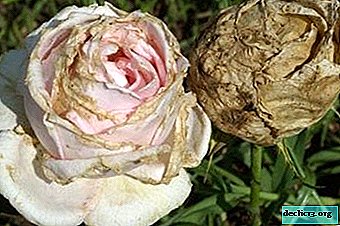 Powdery mildew. With high humidity, shoots and leaves on young bushes are affected. At the same time, a white or grayish tinge appears on the leaves, stems and buds. First, plaque forms in the form of small spots that merge into a continuous mass. The result is the destruction of the affected surface, curl of the leaves and the death of shoots.
Powdery mildew. With high humidity, shoots and leaves on young bushes are affected. At the same time, a white or grayish tinge appears on the leaves, stems and buds. First, plaque forms in the form of small spots that merge into a continuous mass. The result is the destruction of the affected surface, curl of the leaves and the death of shoots.To prevent the disease in autumn, pruning of affected shoots should be carried out, leaves should be collected and burned. In early spring, treatment is carried out with iron sulfate with potassium sulfate or copper sulfate. When infected, shrubs can be sprayed with soda ash. Processing is carried out until the signs of the disease completely disappear.
- Black spotting. This is a fungal disease, which is accompanied by the formation on the leaves, petioles and stipules of spots of a black-brown color of a radiant shape. In this case, the leaves darken, dry and fall. To combat the disease in the fall, dig the soil near the bush, cut and burn damaged shoots. Zinc-containing preparations such as Topaz or Profit should be used.
- Rust. The disease manifests itself in the spring and in conditions of high humidity in the form of orange-brown spots on the stems and leaves. Gradually, spots cover the entire surface of the sheet. At the same time, it dries and falls. For processing, you should spray the leaves with potassium nitrate and treat the plant with copper sulfate.
Thanks to its natural tenderness, Talea roses serve as a real decoration for a personal plot, subject to all strict rules of care, it will delight for a long time with beauty and aroma.

 Powdery mildew. With high humidity, shoots and leaves on young bushes are affected. At the same time, a white or grayish tinge appears on the leaves, stems and buds. First, plaque forms in the form of small spots that merge into a continuous mass. The result is the destruction of the affected surface, curl of the leaves and the death of shoots.
Powdery mildew. With high humidity, shoots and leaves on young bushes are affected. At the same time, a white or grayish tinge appears on the leaves, stems and buds. First, plaque forms in the form of small spots that merge into a continuous mass. The result is the destruction of the affected surface, curl of the leaves and the death of shoots.


